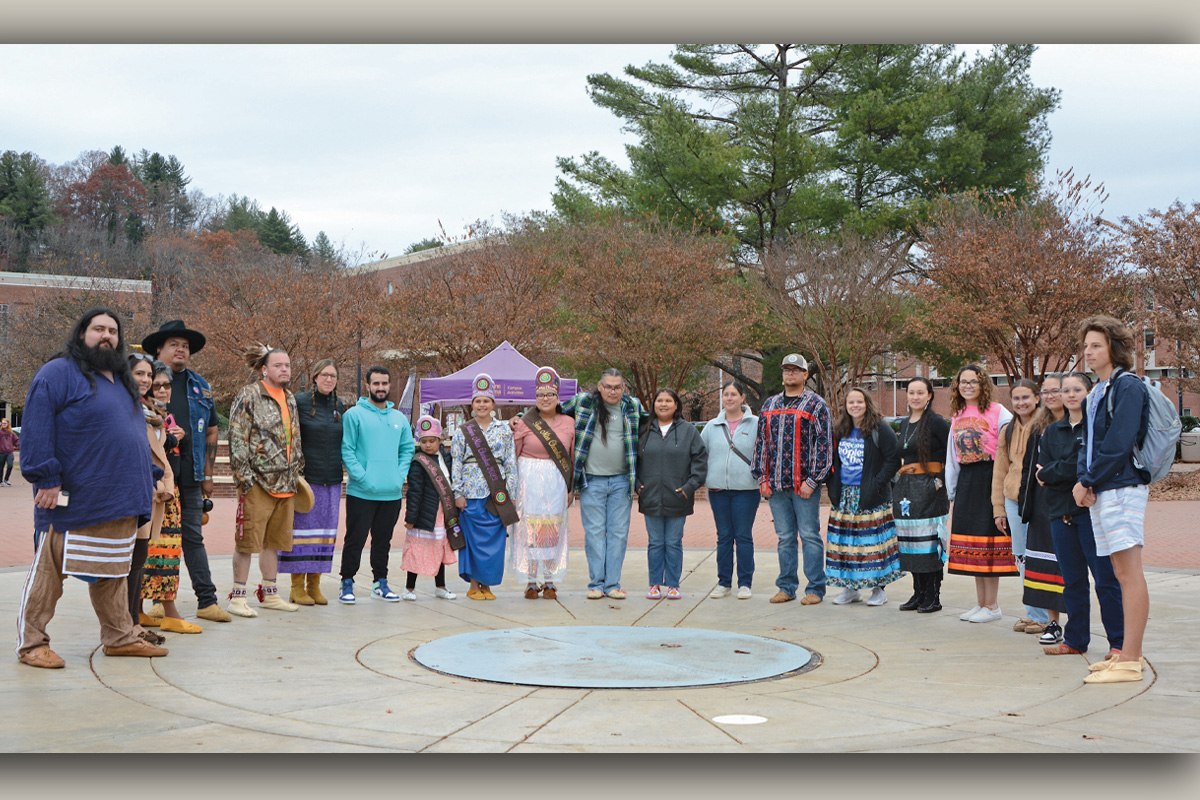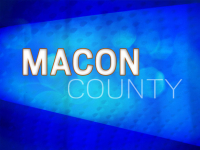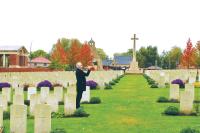Living culture: WCU undertakes project showcasing Cherokee heritage on campus
 The group poses for a picture following the Rock Your Mocs Walk Nov. 15 at Western Carolina University. Holly Kays photo
The group poses for a picture following the Rock Your Mocs Walk Nov. 15 at Western Carolina University. Holly Kays photo
At mid-morning on Wednesday, Nov. 15, the fountain at the heart of Western Carolina University’s campus is a thoroughfare.
People come and go through the concrete courtyard, hurrying toward their next destination. But as the 11 o’clock hour draws closer, a small group begins to gather along the edge. They wear ribbon skirts, ribbon shirts, beaded jewelry and an array of leather moccasins alongside conventional Western apparel like jeans and zip-up fleece — a bright contrast against the drab November sky.
“We come together today to show campus that we are still here as indigenous people, and we’re not just a thing of the past or for history,” said Seth Penn, chairman of WCU’s Digali’i Native American Student Organization.
“We’re here in the present as well.”
The group, which includes members of several different state and federally recognized tribes, has gathered to display pride in their indigenous heritage during a Rock Your Mocs Walk planned as part of WCU’s celebration of Native American Heritage Month. The walk steps off following the arrival of Eastern Band of Cherokee Indians members Jimmy Harlan and Jarrett Wildcatt, who have volunteered to lead the group of 20 students, faculty, staff, community members and EBCI pageant royalty from the fountain down toward the sidewalk rimming the H.F. Robinson Administration Building and back again.
Harlan, wearing feathers in his hair and beaded moccasins on his feet, beats a drum. Wildcatt, wearing the Cherokee style of footwear known as the center-seam pucker toe moccasin, shakes a rattle and sings in the Cherokee language — the Friendship Dance, the Horse Dance and the Wood Gathering Dance.

Related Items
Moccasin styles are unique to the tribe where they originate. Holly Kays photo
“Having a good time, thanking the Creator for everything that’s been bestowed upon us, that’s usually what our songs are for,” said Wildcatt. “Some are for celebration. Some are for prayer. Some are for honoring something or someone. And so they all have a purpose. Everything has a purpose.”
That purpose is intimately connected to the land that now holds WCU’s campus. It’s a place of rich history for the Cherokee people, the site of an ancient town called Tali Tsisgwayahi. In translation, “Two Sparrows Town.” This history is largely invisible to the casual observer, but WCU hopes to shine a spotlight on it through a new project that will showcase Cherokee presence and culture on campus — both historic and modern-day.
“The Cherokee were here before we got here, and I think it’s important for us to not only just acknowledge that but to celebrate that, and to remind ourselves of the Cherokee way of life if we’re going to share this space,” said WCU Interim Associate Provost Carmen Huffman. “And so I think as an educational institution, it’s part of our obligation to teach not only our students but the community about history and heritage and culture of the places and spaces that we occupy.”
The project
Huffman was a bit surprised to find herself leading the charge. Her academic background is in chemistry, not anthropology, and she’s originally from New Hampshire, coming to WCU in 2005 as a lecturer in the Department of Chemistry and Physics. But then she became involved with conversations about design choices for the Apodaca Science Building, which opened in 2021, and observed the conscientious efforts made to pay homage to Cherokee heritage within that design. When the building opened, she’d make sure to point those features out while giving tours.

Design elements in the new Apodaca Building that nod to Cherokee heritage helped jumpstart the project. Holly Kays photo
“Several people and I were talking about how it’s not documented what those design elements are, and so we need some signs or something to draw attention to that,” she said. “And when I gathered people together, particularly folks from our Cherokee Studies Program, it turns out there had been lots of conversation about how we showcase the Cherokee heritage on campus already.”
Huffman took on the role of organizer. The group originally intended to start small, focusing solely on design elements within the Apodaca Building. But when they approached the Cherokee Preservation Foundation about a grant to fund a master planning process, they were met with enthusiasm for a campus-wide project.
“That’s how it kind of blossomed out from just being one little part of campus where we have very interesting design elements to something where we really wrap our arms around all of the things that are related to Cherokee that happened here,” Huffman said.
This spring, WCU landed a $40,000 grant from the Cherokee Preservation Foundation, which the university used to hire the South Carolina-based design firm HW Exhibits to develop a master plan for the project. Huffman expects the project to kick off in January, with stakeholder meetings and a site visit in the spring. The final design plan, to include priorities and phasing for implementation, is expected to be complete in the summer.
From there, it will be up to WCU to find funding to implement the plan. The project will likely involve a mixture of signs, interpretive exhibits, audio tours and artwork that not only highlight Cherokee history and associated design elements on campus but also show what Cherokee culture means today.
“We’ve talked to students, particularly students who have some indigenous relation or are actually tribal members,” Huffman said. “They really want us to focus on the living culture that is what is Cherokee right now.”
Two Sparrows Town
Before WCU was founded in 1889, the land that would eventually form its 600-acre campus was a collection of fields that settlers had farmed for about 70 years after the Cherokee Nation ceded the land in 1819.
Before that, it was Tali Tsisgwayahi, “Two Sparrows Town.”
“We have limited information because this community, the town itself, does not show up in European records,” said Brett Riggs, Sequoyah Distinguished Professor of Cherokee Studies at WCU.
But research has shown that the town was an important one for the Cherokee people. In the 1820s, Assistant Principal Chief Charles Hicks wrote a letter in English detailing oral history, as he had heard it recited in the 1770s, discussing the migrations of the Cherokee people. In that letter, he pointed to Two Sparrows Place as what Riggs paraphrased as “the starting point for the current configuration” of the Cherokee people.
“There was another testimony given by a Cherokee elder in the 1830s that it was a place where the hills that surrounded the town were great cities of the immortal beings,” he said.
They viewed the towering mountains as giant versions of the councilhouses that were the center of religious, community and political life in Cherokee towns. Built atop large mounds of dirt, the councilhouses were themselves covered with earth once complete, looking much like miniature versions of the surrounding mountains.

One such councilhouse once stood on WCU’s campus , a prominent presence on the landscape. Between 40 and 50 feet in diameter, the councilhouse was likely about half as tall as it was wide and stood on a mound that was 12 feet tall as of the earliest available record. The entire construction would have risen more than 30 feet above the rest of the town, which Riggs said was a closeknit community that likely included 120-400 people.
“It’s not the way we think of a town in our western brain,” he said. “We think of a town as a structure where people come and go. In the Cherokee sense, the town, that is the people.”
For decades after the United States government forced the Cherokee people west, the mound stood in a farm field known as “townhouse field,” Riggs said. Then, in 1956, it was bulldozed to make way for construction of central campus. The site is currently buried under Killian Building.
“Central campus is built on top of this ancient community,” Riggs said.
In many places, that original surface is buried under fill dirt, so whenever new construction takes place, archeological work commences . In digs conducted in preparation for construction of intermural fields near Norton Residence Hall, Riggs said, WCU archeology students found a fortified town that was probably about 1,000 years old and evidence for individual houses dating to the late 1500s or early 1600s, including an entire house that had burned, collapsed and been preserved in the earth, complete with a dozen ceramic vessels that were crushed when the building burned.
“We’re regularly encountering evidence of the ancient historical Cherokee presence here on campus in the form of archaeological remains that we see with practically any construction that goes on in the more level parts of the campus,” Riggs said.
Recovered materials go to the university’s curation facility, which in 2019 was renamed Two Sparrows Town Archeological Collections Curation Facility in honor of the community that once thrived there.
Living culture
But Cherokee history is not a static thing — it’s still being written. Tribal members hope to see WCU’s new project shine a spotlight on the tribe’s continued existence, putting forth a simple message: “we are still here.”

“I don’t want them to be stereotypical, watching what they see on Hollywood in the form of an Indian,” Harlan said of the impact he hopes the project has on the Cullowhee community. “I want them to know that we’re still here, that we still thrive. And that we still have a purpose.”
Many institutions, including universities, have begun emphasizing Native ties to the land through land acknowledgements read at official gatherings. But those acknowledgements tend to focus on the past.
“I’ve had a few professors acknowledge the current setting, and those of us who are here on campus, but the majority don’t think to do that,” said Penn, who is a member of the state-recognized Cherokee Tribe of Northeast Alabama. “So I would like to see more of the acknowledgement of the present, and the fact that the indigenous people, and especially the indigenous students here at Western, we’re going to be in the classrooms with you … we’re trying to get along and live in community with everyone the best we can, but we very much hold to our culture, our traditions, our languages and even for some of us, our religious beliefs.”
Penn added that, in his opinion, WCU does a better job than most in this department — it offers a Cherokee studies program, funds a Cherokee Center on the Qualla Boundary and works to foster a relationship with the EBCI. But still, emphasis on action remains important.
“While it’s all nice and good to acknowledge, ‘Oh, yes, this is the land of the Cherokee people. This is called Tali Tsisgwayahi, Two Sparrows Town,’ — yes, that’s great and all,” Wildcatt said, “but what actions are you taking to either give the land back in some way, or what are you trying to do to incorporate Cherokees into where you’re at?”
Elias Huskey, administrative support associate for WCU’s Cherokee Center, said he’d like to see the project result in some physical changes on campus to underscore Cherokee presence, such as displaying Cherokee syllabary translations of roadsigns. Such an effort is already in progress, he said, and he looks forward to seeing it come to fruition. He’d also like to see more events and general recognition of Cherokee heritage throughout the year — not just on Indigenous People’s Day in October and Native American Heritage Month in November.
“It would be cool to be more tied in, if that makes sense, more robustly represented, because we have a huge population,” he said.
Roughly half of the Eastern Band of Cherokee Indians’ 16,000 enrolled members live on the Qualla Boundary, about 30 minutes away from WCU, and many more are scattered throughout the tribe’s five-county service area of Haywood, Jackson, Swain, Cherokee and Graham counties. The tribe has a program in place to foot the bill for any tribal member who wishes to go to college, so that’s a potentially large market for WCU to tap into, Huskey said.
But thus far, Native American students make up a small subset of WCU’s 11,628 students. This fall, 87 of the school’s undergraduate students and seven of its graduate students self-identified as American Indian or Alaska Native, with an additional 227 students self-identifying as two or more races including American Indian or Alaska Native. WCU’s records don’t specify how many of those students are EBCI members, but it’s likely that most of the 76 students who self-identified as at least partially Native American or Alaska Native and reside in the tribe’s five-county service area are associated with the EBCI.

Students march in the Rock Your Mocs Walk (top) led by Eastern Band of Cherokee Indians members Jimmy Harlan (above right) and Jarrett Wildcatt (above). Holly Kays photos
Asking for reasons why so few EBCI members attend WCU yields a variety of speculative answers — WCU is too close to home for students looking to get out and see the world, many potential students aren’t aware of what WCU has to offer, young people often face other life circumstances that prevent them from going to college, for example — but some hope that better showcasing Cherokee heritage on campus could encourage more Native students to feel at home there.
“I’m not sure we’re trying to use this as a way to bolster enrollment of EBCI members, but I do think it’s important for us to take an active role in ensuring that they feel like they belong here,” said Huffman. “Our campus theme this year is community and belongingness, and so I really love the idea that this is something that potentially would make those students feel like WCU is an extension of their Qualla Boundary home.”









